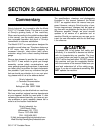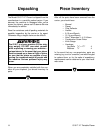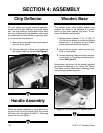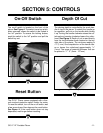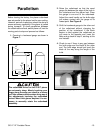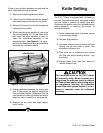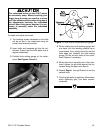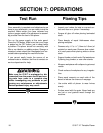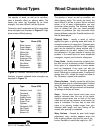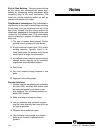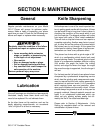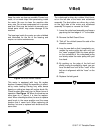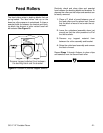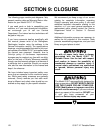
G1017 12'' Portable Planer -17-
Figure 12. Common hardwood shear strengths.
The species of wood, as well as its condition,
have a dramatic effect on planing ability. The
harder the wood (as illustrated by its shear
strength), the more difficult it will be to plane.
Commonly used hardwoods and their associated
shear strengths are illustrated in Figure 12. High
shear means difficult planing.
Similarly, common softwood shear strengths are
displayed in Figure 13.
Wood Types
Type Shear (PSI)
Black Locust 2,480
Sugar Maple 2,330
Pecan Hickory 2,080
White Oak 2,000
White Ash 1,950
Black Cherry 1,700
American Elm 1,510
Black Walnut 1,370
Red Alder 1,080
Basswood 980
Cottonwood 930
Increasing
Difficulty
Figure 13. Common softwood shear strengths.
Type Shear (PSI)
Western Larch 1,410
Tamarack 1,280
Douglas Fir 1,160
Alaska Cedar 1,130
Sitka Spruce 1,150
Sugar Pine 1,050
Cypress 1,000
Redwood (OG) 940
Red Cedar 860
White Pine 850
Balsam Fir 710
Increasing
Difficulty
Wood Characteristics
The species of wood, as well as condition, will
affect planing ability. The harder the wood, the
more difficult it will be to plane. We’ve included
below, a list of wood characteristics you may
encounter when planing. The following descrip-
tions of defects will give you some possible
answers to problems you may encounter while
planing different materials. Possible solutions fol-
low the descriptions.
Chipped Grain - usually a result of cutting
against the grain, or planing wood with knots or
excessive amount of cross grain. Chipped grain
can also be caused by dull knives. Often, chipped
grain can be avoided by taking shallow cuts. If
those options do not work, inspect your lumber
and determine if its grain pattern is causing the
problem. If the wood does not show substantial
crossgrain, inspect your knives for sharpness.
Fuzzy Grain - Usually caused by surfacing lum-
ber with too high a moisture content. Sometimes
fuzzy grain is a characteristic of some woods,
such as basswood. Fuzzy grain can also be
caused by dull knives or an incorrect grinding
bevel. Check with a moisture meter. If moisture is
greater than 20%, sticker the wood and allow to
dry. Otherwise, inspect knife condition.
Glossy Surface - Usually caused by dull knives
taking shallow cuts at a slow feed speed. Surface
gloss will usually be accompanied by overheat-
ing. Often, lumber will be scorched and eventual-
ly, damage to knives will occur.
Snipe - Occurs when board ends have more
material removed than the rest of the board.
Usually caused when one or both of the bed
rollers are set too low. However, small amount of
snipe is inevitable. The best way to deal with
snipe is by planing lumber longer than your
intended work length and then cutting off the
excess after planing is completed.
Wavy Surface - Caused by poor knife height
adjustment, wavy surface appears when one
knife is taking deeper cuts than the rest of the
knives. Recheck or reset knife height to ±.001''.



